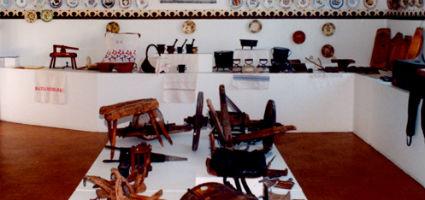2024. April 26. Friday
József Berey Region History Collection and Galery - Nagyecsed
 |
Address: 4355, Nagyecsed Vásár tér
Phone number: (44) 545-005
E-mail: muvhaz@nagyecsed.hu
Opening hours: Wed-Mon 9-13
On prior notice: anytime |
Nagyecsed is in Szabolcs-Szatmár-Bereg County, close to the Romanian border. The little town of 7500 people belonged to the Marshes of Ecsed. Ecsed was named at the time of the Original Settlement. The name Ecsed meant 'younger brother'.
The village was made popular by the fortress that once stood there. Both the Báthori and Rákóczi family praised it. It was impossible to invade the fortress due to the marshes around it. However, the marshes were drained in 1894-98.
Our collection of local history was created in 1988. The excavations on the Sárvár Hill played significant part in its establishing. The archeologist Magyar Kálmán of Kaposvár supervised the excavations in 1975-77. The remains of a monastery from the 11th century and an earthwork were found on the island close to the village. This area was already populated in the ancient times when the people lived on the islands that arose from the marshes.
At the time of the Original Settlement the leader Tas invaded this area. Later the Báthori family that originated in the German Gut-Keled tribe took the place over. They built a castle in the 14th century that made Ecsed famous for the following centuries. Unfortunately, the remains of the castle have all disappeared by now except for some stones that were preserved.
These and remains from the Sárvár Hill make up the material of the permanent exhibition.
The other permanent exhibition shows the ethnographic material collected in the village.
The village was made popular by the fortress that once stood there. Both the Báthori and Rákóczi family praised it. It was impossible to invade the fortress due to the marshes around it. However, the marshes were drained in 1894-98.
Our collection of local history was created in 1988. The excavations on the Sárvár Hill played significant part in its establishing. The archeologist Magyar Kálmán of Kaposvár supervised the excavations in 1975-77. The remains of a monastery from the 11th century and an earthwork were found on the island close to the village. This area was already populated in the ancient times when the people lived on the islands that arose from the marshes.
At the time of the Original Settlement the leader Tas invaded this area. Later the Báthori family that originated in the German Gut-Keled tribe took the place over. They built a castle in the 14th century that made Ecsed famous for the following centuries. Unfortunately, the remains of the castle have all disappeared by now except for some stones that were preserved.
These and remains from the Sárvár Hill make up the material of the permanent exhibition.
The other permanent exhibition shows the ethnographic material collected in the village.

